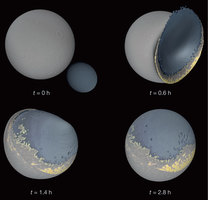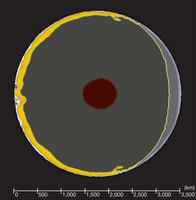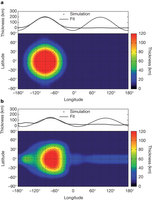摘要:月球是有两个截然不同半球的卫星。始终朝向我们的“近地面”高度低、平坦、且为暗色,而“远地面”则多山并有很深的陨石坑。Martin Jutzi 和 Erik Asphaug提出,月球的这种“二分状况”也许是晚期吸积另一相伴卫星所造成的。相伴卫星是巨大撞击的一个常见结果,而原始“月盘”模拟及新的计算表明,以亚音速撞击速度与一个相伴卫星相撞会导致一个“吸积堆”而不是一个陨石坑,这样产生的一个半球层是与“远地面”高原地形的尺寸和壳层结构一致的。
生物探索推荐英文论文摘要:
Nature 476, 69–72 (04 August 2011)
Doi:10.1038/nature10289
Forming the lunar farside highlands by accretion of a companion moon
Abstract:
The most striking geological feature of the Moon is the terrain and elevation dichotomy between the hemispheres: the nearside is low and flat, dominated by volcanic maria, whereas the farside is mountainous and deeply cratered. Associated with this geological dichotomy is a compositional and thermal variation, with the nearside Procellarum KREEP (potassium/rare-earth element/phosphorus) Terrane and environs interpreted as having thin, compositionally evolved crust in comparison with the massive feldspathic highlands. The lunar dichotomy may have been caused by internal effects (for example spatial variations in tidal heating, asymmetric convective processes or asymmetric crystallization of the magma ocean) or external effects (such as the event that formed the South Pole/Aitken basin or asymmetric cratering). Here we consider its origin as a late carapace added by the accretion of a companion moon. Companion moons are a common outcome of simulations of Moon formation from a protolunar disk resulting from a giant impact, and although most coplanar configurations are unstable, a ~1,200-km-diameter moon located at one of the Trojan points could be dynamically stable for tens of millions of years after the giant impact. Most of the Moon’s magma ocean would solidify on this timescale, whereas the companion moon would evolve more quickly into a crust and a solid mantle derived from similar disk material, and would presumably have little or no core. Its likely fate would be to collide with the Moon at ~2–3 km s−1, well below the speed of sound in silicates. According to our simulations, a large moon/Moon size ratio (~0.3) and a subsonic impact velocity lead to an accretionary pile rather than a crater, contributing a hemispheric layer of extent and thickness consistent with the dimensions of the farside highlands and in agreement with the degree-two crustal thickness profile. The collision furthermore displaces the KREEP-rich layer to the opposite hemisphere, explaining the observed concentration.

Figure 1: Moon/companion moon collision.

Figure 2: Post-impact internal structure.

Figure 3: Post-impact spatial distribution of the impactor and thickness profile.







